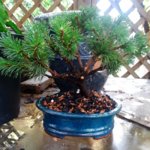That's the spirit!

Can't make an omelet without breaking a few eggs!
Even though I know better, I still cannot give up on a tree until it is a leafless dead stick. There's still the chance, but I think it is good to observe how it passes. The surefire testament of a dead pine is stiff/hard/crumbly terminal bud. I find it amazing how some needles in the middle can seem to still be alive for the longest time ...
Lesson 2: What you did in getting rid of the original nursery soil/dirt is called 'bare rooting'. You cannot do this with a few other species, regardless of timing, notably Japanese black pine (aka JBP = pinus thunbergii) and Japanese red pine (aka JRP = pinus densiflora). I've also killed a few hemlocks (tsuga canadensis) by bare rooting. With these you should clean out the dirt from the roots on only one side of the trunk. Pot it in substrate, let grow for a year and then repot, cleaning out the other half = a process we call half bare rooting (HBR). HBR is the safe way to accomplish the task for any/every species. On the other hand deciduous species (angiosperms) can be bare rooted with impunity in spring 'as buds swell'.
I don't mean to deter you from undertaking whatever suits your fancy meanwhile, but nurseries and garden centers will be reducing prices somewhat now that the spring rush is over. And near the end of the season they will strongly slash them (but the selection will be very resticted). These are good times to buy stuff to learn with. I suggest that you grab what interests you and get more than one of each, if you are so inclined. You could then maybe repot one of a pair, say, in late-summer/early fall and the other not. Then get them through the winter and repot the remainder 'as buds swell' early next spring. Then in addition to keeping them alive and thriving, you might also experience some of those exciting bonsai things like trunk chopping a deciduous tree (e.g. a maple), maybe defoliating another, make an air layer, decandle a pine or two, and etc, for the first time if you haven't already.


